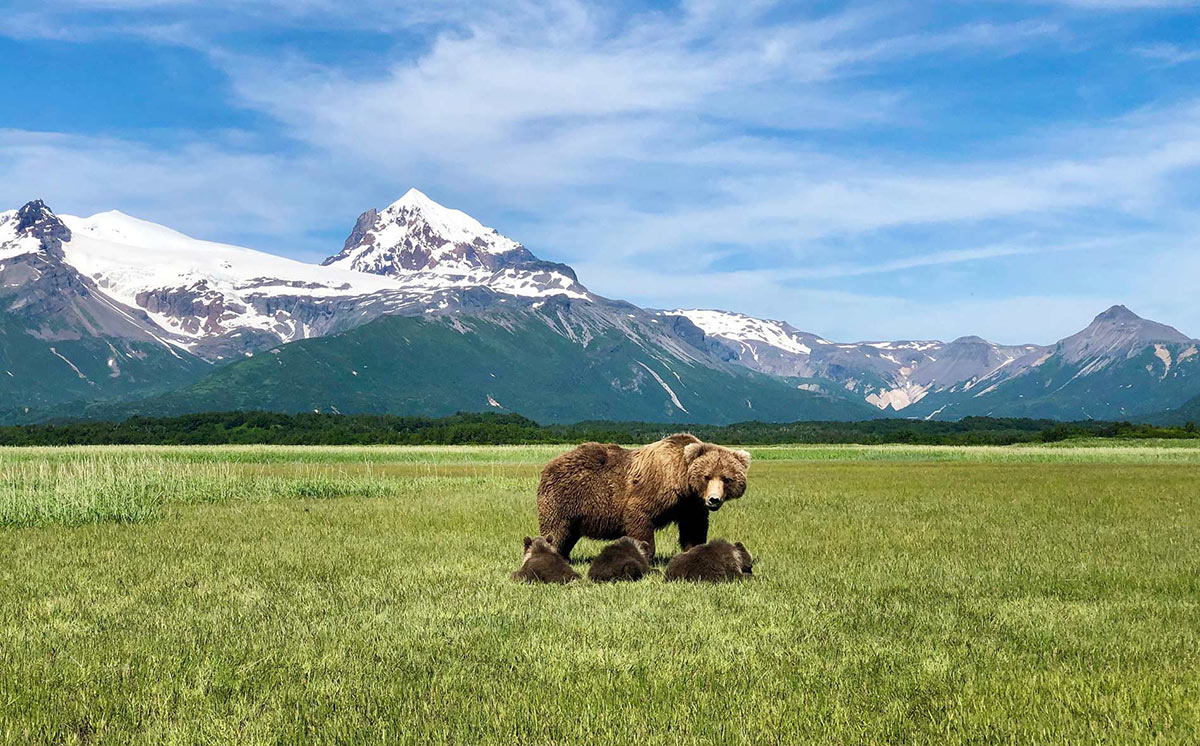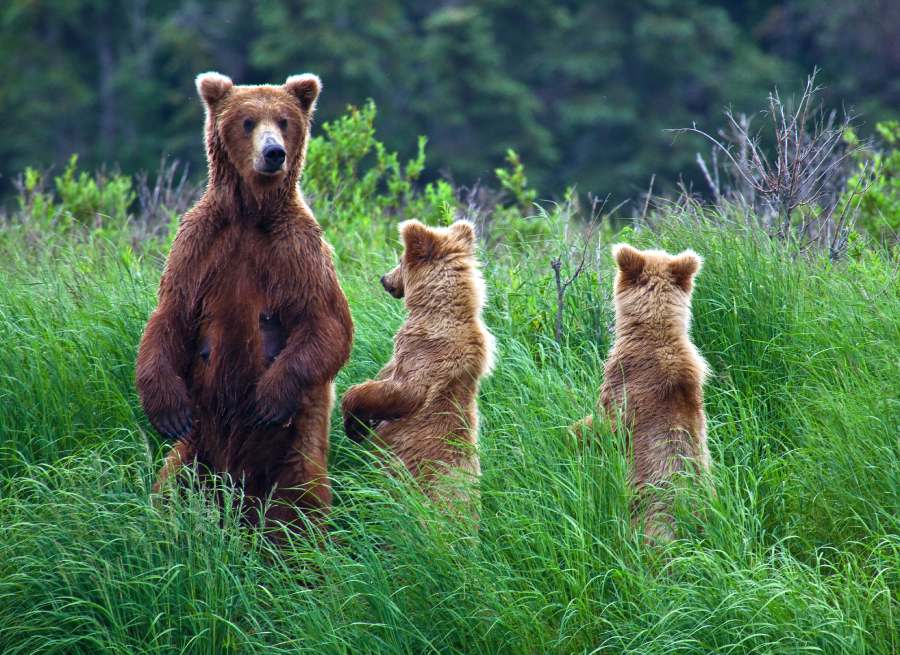 Brown Bear life cycles follow the seasons and the demands of their lifestyle—particularly for those living in the Alaskan wilderness who must cope with cold and snowy winters. The average life span for a Brown Bear in the wild is about 20 years. However, the oldest known Brown Bear lived for 35 years in the wild.
Brown Bear life cycles follow the seasons and the demands of their lifestyle—particularly for those living in the Alaskan wilderness who must cope with cold and snowy winters. The average life span for a Brown Bear in the wild is about 20 years. However, the oldest known Brown Bear lived for 35 years in the wild.
From being born in a den in the depths of winter to maturing into master salmon catchers, this article will dive into the fascinating patterns of Brown Bear life cycles.
The Birth of Brown Bears
Alaskan Brown Bears give birth to their cubs in their winter dens during January and February. Typically, a female will have a litter of between one and three cubs, although occasionally litters of four can occur.
The cubs are born tiny, hairless, and sometimes weigh less than half a pound. Like most newborn mammals, they depend completely on their mothers for survival. They spend their first few months in the cozy den with their mother, relying on her warmth and protection for the rest of the winter. They nurse on her milk to help them gain weight in preparation for leaving the den in the spring.
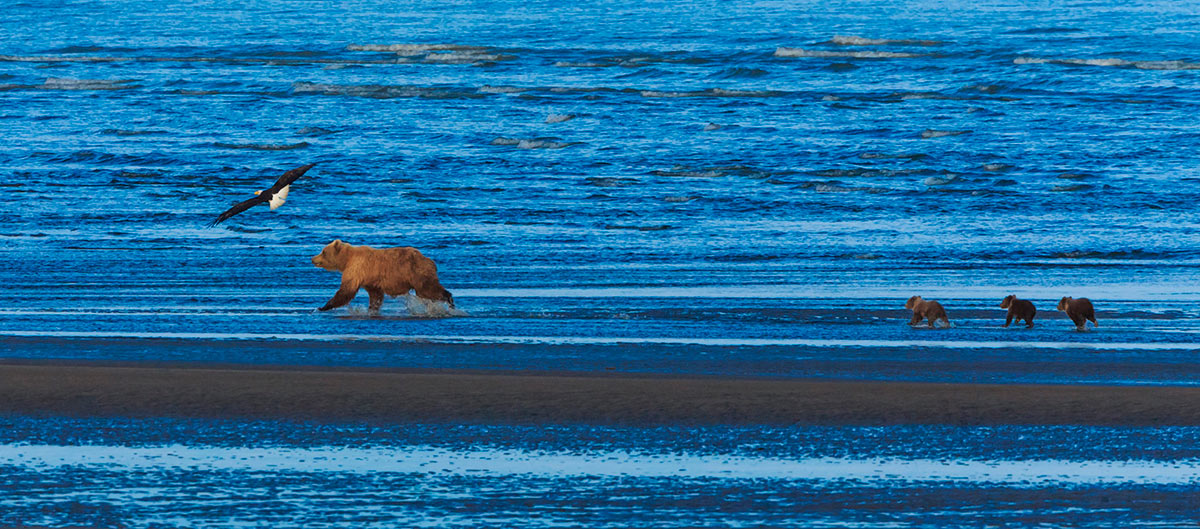
The Stages of the Brown Bear Life Cycle
Once spring has arrived, around April and May, Brown Bears emerge from their winter slumber and leave their dens in search of food. Mother bears are very protective of their young cubs; the family stays together for the first two or three years of the cub’s lives. Male grizzlies have no part in raising cubs and can sometimes pose a threat to them.
As the days grow longer and the temperatures rise, the lush greenery of spring provides ample opportunities for Brown Bears to replenish their depleted energy stores after the long winter. The mothers diligently teach their cubs essential survival skills such as foraging for food and identifying potential dangers in the wilderness. While the male grizzlies may not be involved in raising the cubs, their presence can still create tense encounters, especially during the mating season when territorial disputes often arise. Despite these challenges, the bond between a mother bear and her cubs remains unbreakable, ensuring the family’s continued well-being in the rugged landscape they call home.
If you go on a trip to see bears, you might see cubs of different ages and sizes being referred to as “spring cubs” or “yearlings”—we’ll explain what that means next.
Spring Cubs
Spring cubs is a term used for Brown Bears that were born earlier that year—they are cubs that first emerged this spring. When spring arrives a few months after they are born, the cubs will have grown to weigh anywhere between four and eight pounds. Spring cubs are also sometimes called ‘COYs’, which stands for ‘Cubs of the Year’.
Once they leave the den, cubs begin to explore the world around them. They stay close to their mothers, learning essential survival skills like fishing and foraging. They still feed on their mother’s milk but also start eating solid food, including berries and other plants. As they grow, the cubs explore their surroundings under the watchful eye of their protective mother bears. As the cubs grow more confident in their abilities, they gradually become more independent from their mothers. They start practicing their hunting skills by play-fighting with their siblings and mimicking their mother’s movements. The young bears develop a strong bond with their family members, forming a close-knit social unit within the vast wilderness. While the mother bear continues to provide guidance and protection, the cubs also learn valuable lessons through observation and hands-on experience, preparing them for a life of self-sufficiency in the wild.
Yearling Cubs
Brown Bear cubs stay with their mothers for the first few years of their lives. After their first hibernation, a cub is referred to as a yearling—they are one year old and this is their second year of life. The cubs have grown significantly, but they continue learning from their mother, gradually becoming more independent and preparing for their lives as adults. Yearlings will den with their mother for at least one more winter.
As the yearling cubs continue to develop, they start to explore their surroundings more independently, honing their skills in fishing, foraging, and other essential activities. They accompany their mother on hunting trips, observing her techniques and gradually practicing them under her watchful eye. Although still reliant on their mother for guidance and protection, the yearlings are becoming more self-sufficient with each passing day. Their bond with their mother remains strong, but soon they will need to venture out on their own and establish their territories in the vast wilderness.
Second and Third Year Cubs
Second-year cubs are even bigger than yearlings while third-year cubs are almost full-grown! By now, they are well on their journey towards independence, becoming more self-reliant and confident.
An important step in the Brown Bear life cycle is when they become independent. The age a Brown Bear cub becomes independent from its mother can vary, but in Katmai National Park, Alaska, cubs will generally stay with their mothers for two and a half years. Katmai bears generally separate from their cubs in May or June of a cub’s third summer. However, some females will keep their cubs through a third summer and hibernation, before separating during the next spring.
As young brown bear cubs grow independent from their mothers, they embark on solo journeys, refining their foraging and survival skills gleaned through observation. This pivotal transition signals a crucial developmental stage, as they put into practice the lessons learned alongside their mothers. Venturing beyond the security of maternal guidance, they test their prowess in navigating the wilderness. Though the maternal bond endures, it’s time for these young bears to carve out their own identities and roles within the ecosystem.
Subadults and Adults
When Brown Bears have become independent of their mothers, but have not yet reached sexual maturity, they are known as subadults. Subadult Brown Bears are typically between two and a half and five and a half years old.
Once Brown Bears reach five to six years old they are usually classified as adults. The distinction between a subadult and an adult bear is defined by the point they reach sexual maturity. Like in many animals, there is no set age when this happens but in a Brown Bear’s life cycle, it generally occurs around the bear’s sixth year.
Upon reaching adulthood, Brown Bears achieve full maturity and reproductive capability. Typically, adult female bears commence breeding between five to eight years of age, while males attain sexual maturity around a similar timeframe. At this juncture, adult Brown Bears embark on territorial establishment and may partake in mating rituals during the breeding season. Serving as apex predators, these mature bears hold a pivotal position in ecosystem equilibrium, actively fostering biodiversity and environmental well-being.
The Salmon Run
Alaskan Brown Bears are opportunistic eaters and will eat almost anything. Their diet consists of berries, grasses, flowers, roots, carcasses, small mammals and, famously, salmon.
A significant part of a Brown Bear’s life cycle is the Salmon Run. From June – September each year, salmon swim upriver to reach their spawning sites—a phenomenon known as the Salmon Run. Alaskan Brown Bears gather around rivers in large numbers to feed on these salmon.
Alaskan Brown Bears require a high caloric intake of food, they can eat 80 to 90 pounds of food per day. This is necessary for them to gain weight and store fat for their winter hibernation. A large, dominant male bear sometimes catches and eats more than 30 fish daily.
During the Salmon Run, the riverbanks transform into bustling banquets for Alaskan Brown Bears. Witnessing these massive creatures exhibit exceptional fishing prowess amidst the swift and elusive salmon is a natural spectacle. The competition for prime fishing spots intensifies, often sparking displays of dominance and aggression among the bears. Upon successfully securing a catch, a bear deftly employs its formidable jaws and claws to rend the fish’s flesh, consuming the nutrient-rich meal with remarkable efficiency. This period of abundance is pivotal for the bears, allowing them to bolster their reserves and prepare for the demanding winter months ahead.
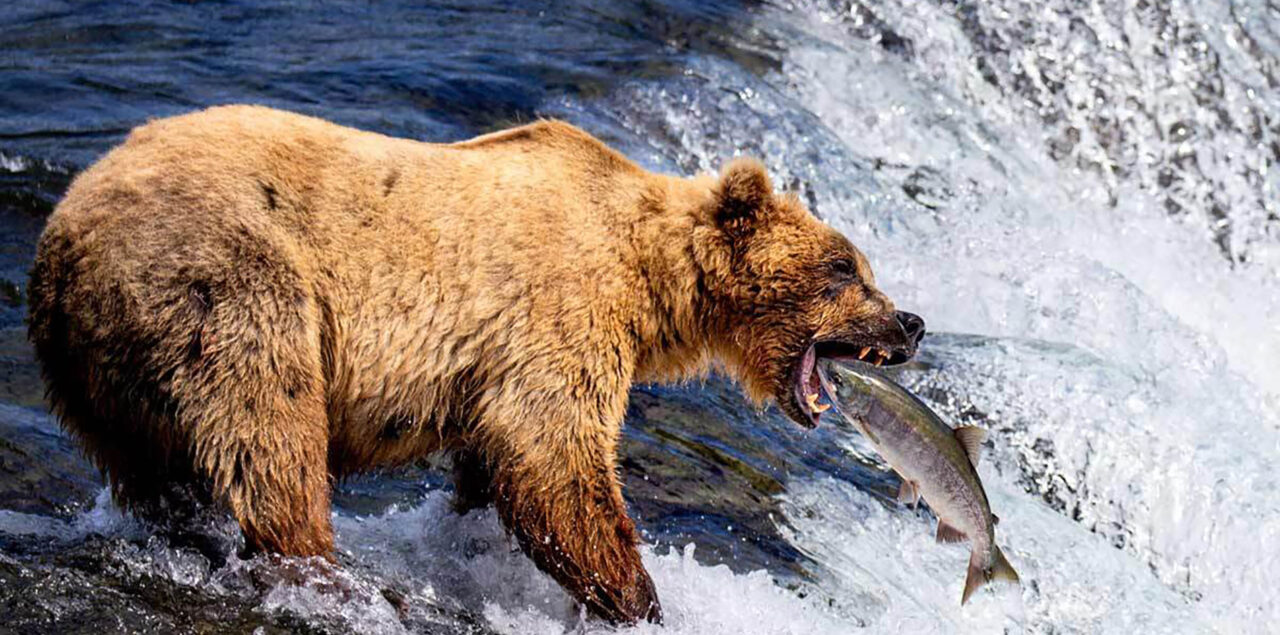
Hibernation
Hibernation is a big part of the Brown Bear life cycle. Hibernation is state of dormancy that allows animals to avoid periods of intense cold and food shortages, such as the cold Alaskan winter. For Brown Bears, hibernation can last between five and eight months, and they spend it in a den, typically dug into a hillside.
In Katmai National Park, Alaska, bears have not been seen using the same den for multiple winters, and they’re not known to den in sites like caves or crevasses. Most bears in Alaska go to their den and begin hibernation in October and November. This is most likely triggered by hormonal changes and a shortage of food.
Surviving a winter without food or water requires lots of fat reserves. Alaska Brown Bears spend the summer months preparing for their hibernation by gorging on food, such as fish during the Salmon Run, to increase their fat stores.
Understanding the Brown Bear’s Remarkable Metabolic Changes During Hibernation
The mechanics of Brown Bear hibernation are fascinating. During hibernation, a bear’s body temperature remains around 88˚F, only slightly lower than their normal body temperature of 100˚F. Their heart and respiratory rates drop dramatically—they average one breath per minute and have a heart rate of eight to ten beats per minute.
Brown Bears do not eat, drink, or defecate at all during hibernation. Their body fat is metabolized to produce water and food, which they recycle instead of defecating. Their kidneys almost shut down completely and urea (a major component of urine) is recycled into proteins. These proteins maintain the bear’s muscle mass and body tissues.
When they emerge from their dens in the spring, most bears have lost up to 33 percent of their body weight from using up their fat reserves. Lactating females can lose even more weight due to the energy they use to produce milk for their cubs. Remarkably, healthy bears still emerge from hibernation in the spring without losing any muscle mass and bone density—just with a bit less body fat than before!
Mating Brown Bears
Female Brown Bears do not mate until they are at least four to six years of age. Mating season occurs from mid-May to mid-July and bears will mate with multiple partners during the season. Male Brown Bears compete for the attention of females, fighting to establish dominance.
Female Brown Bears who have previously had cubs are not ready to mate until they are no longer lactating and their last litter of cubs has become independent—typically within two to three years after birth. When the time comes, female Brown Bears will sever the bond with their cubs, using threats of aggression to encourage the young to disperse. This can be exacerbated by the presence of a male Brown Bear—a potential father for her next litter.
If a female Brown Bear has successfully mated, the embryo will start to develop once she enters her den in the fall – a process called delayed implantation. After about eight weeks, the cubs are born in January or February, and the Brown Bear life cycle begins again.
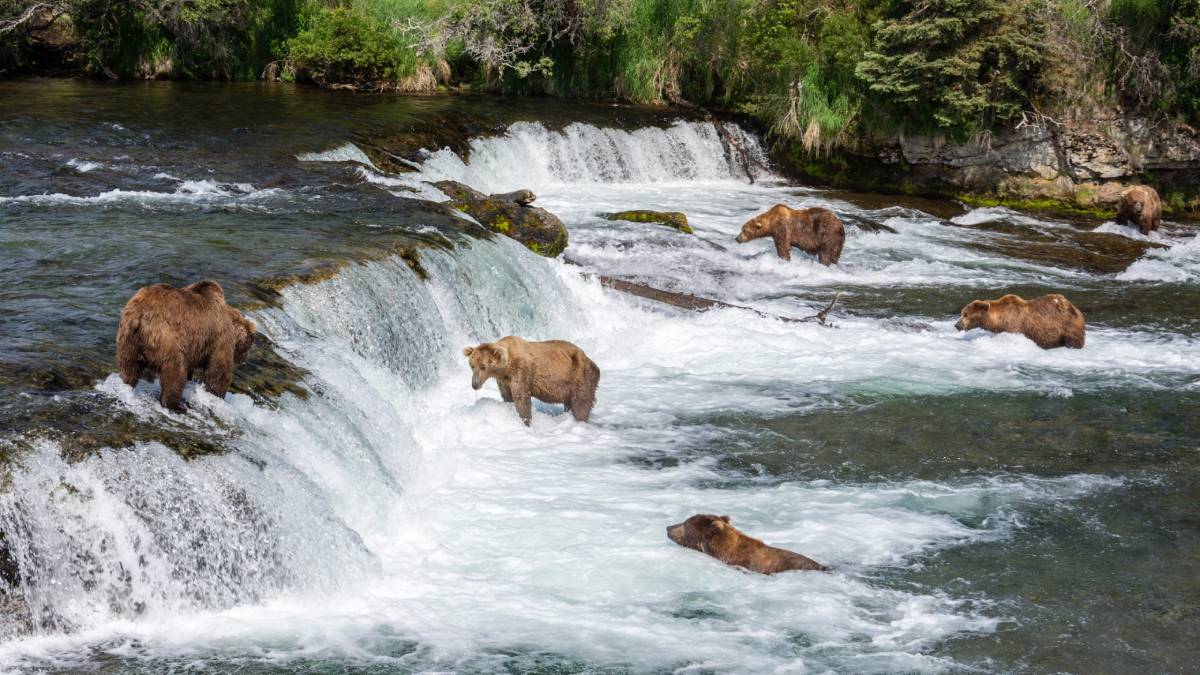
Alaskan Brown Bears are truly remarkable creatures, with each stage of the Brown Bear life cycle offering a glimpse into their world and its challenges. Their capacity to survive in such an extreme environment as the Alaskan wilderness results from masterful adaptations and the ability to really eat!
Learn more about the birds of Alaska! Alaska is home to a diverse array of bird species, including majestic bald eagles, colorful puffins, and graceful sandhill cranes. Birdwatchers flock to Alaska to catch glimpses of these avian wonders in their natural habitats, from coastal cliffs to vast wetlands. With its vast wilderness and rich biodiversity, Alaska provides an unparalleled opportunity to observe and appreciate the fascinating world of birds.
Sources:

